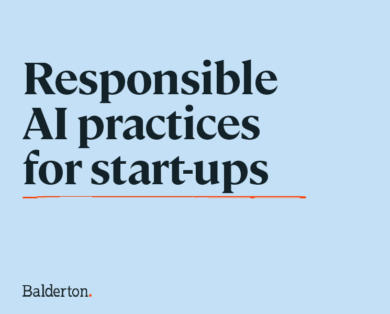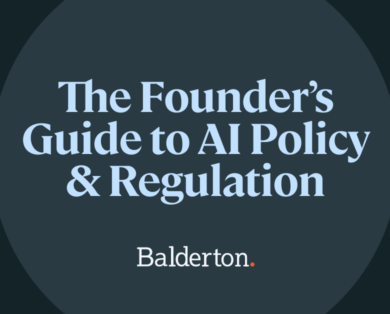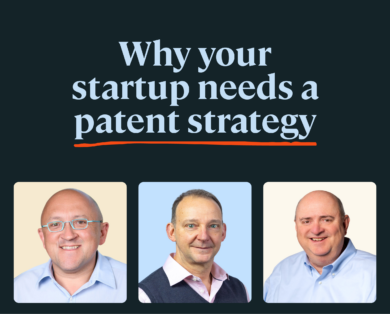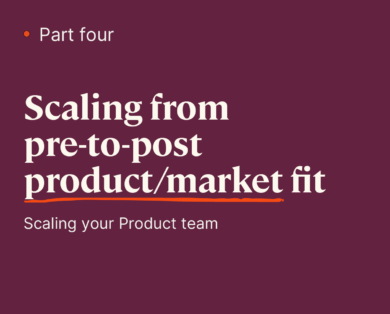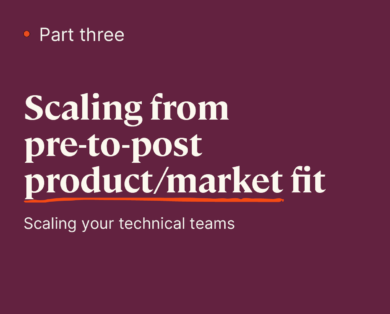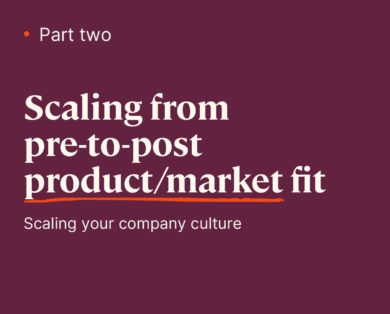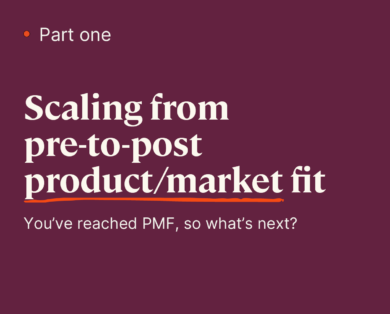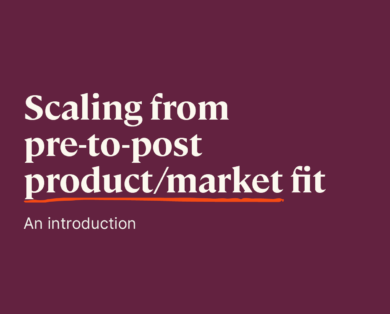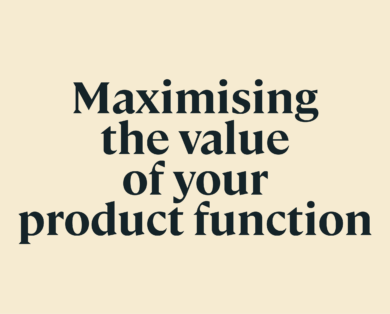- 20 November, 2024
This post is co-authored by: Nicholas Andreou (Big Society Capital) & Magda Lukaszewicz (Balderton Capital)
While the world has never been short of social and environmental challenges, there is a growing recognition that business has a fundamental role to play. As Paul Polman notes, the economy cannot thrive unless people and planet are thriving. Increasingly, business leaders want to set up and grow businesses that avoid harm, benefit stakeholders, and contribute to solutions. Or, as it’s increasingly being referred to, create impact.
At Big Society Capital, we believe that by working with market leading venture firms we can both accelerate mainstream capital’s shift to impact and help shape it towards more meaningful engagement with impact. We’re excited to be working with Balderton on developing their approach to impact as part of their exciting Sustainable Future Goals initiative. Read more on why we invested here.
At Balderton, many of our portfolio companies are tackling impact issues (e.g. Infarm, Zego and Wagestream), either with the products and services they build or through the ways they are choosing to build their companies.
We believe the best entrepreneurs will scale their companies in ways that are respectful to the planet and societies that they operate in.
We hope that this blog can serve as a guide on the impact journey during the main stages of building a venture-backed business.
This blog is a collaborative piece of work that puts forward a set of practices to help tech founders drive both impact and financial performance. First, we start with a few clarifications:
IMPACT FUNDAMENTALS
What does ‘impact’ mean?
‘Impact’ has no agreed-upon definition. The closest we’ve reached to a consensus is the Impact Management Project’s definition: ‘a change in outcomes for people and/or planet’. A comprehensive list of impact-related outcomes is captured in the UN’s Sustainable Development Goals.
What are the pathways to impact?
There are three sources of impact:
- Impactful business models – i.e. through selling impactful products
- Impactful operations – i.e. decisions are made across the value chain which affect impact (analogous to ESG) and are applicable to any company regardless of whether its business model is explicitly targeting impact
- Impactful profits – the traditional model of creating impact for a firm: through philanthropy, CSR, or cross-subsidizing models
Each source of impact then plays out in two ways:
- Directly – impact is created as a direct consequence of an action
- Indirectly – impact is enabled further down the value chain, often with a time lag
| Source of impact: | Direct | Impact |
| Business Models | Wagestream: Its affordable finance product generates impact with each transaction | SOPHiA Genetics: As a B2B model, impact isn’t created directly with each transaction, but the improved analysis and treatment-related insights the platform generates allows medical institutions to enhance their impact |
| Operations | Lyft: Its ESG policy has a number of initiatives aimed at reducing the burden on the environment and improving driver wellbeing | Tesla: Its open source approach to innovation enables other actors in the ecosystem to accelerate the transition to green |
| Profits | Headspace: A cross-subsidy model helps to extend mindfulness related outcomes to lower income populations | Oyster: An HR platform enabling distributed employment with discounts for charities and social enterprises. Making talent acquisition cheaper strengthens the financial position of charities helping them create more impact through their programmes |
In a venture context, most impact investors are looking for impactful business models as these provide the highest leverage for impact (smaller teams reaching much larger user groups). Maximal impact is created by a company pulling all three of these levers whilst also managing negative impacts to create as much net impact as possible.
BUILDING A PRODUCT
Embedding impact into the business model starts at the very beginning of the venture journey in choosing a problem and building a product that solves that problem. Funding wise, this stage typically corresponds to angel, pre-seed or seed funding.
This first phase is particularly impact-focused and includes:
- Founding team impact ambition
- Understanding the social or environmental problem
- Articulating an impact thesis
- Iterating for impact
1. FOUNDING TEAM WITH IMPACT AMBITION
What is it and how does it align with traditional venture building?
A critical step in getting a venture off the ground is building the founding team and the one or two fundamental early hires. This is about incorporating a desire to create impact as an input into those decisions.
How does it drive impact?
Talent is a key determinant of what a startup will achieve, the same is true for impact outcomes. Building a founding team with people who have impact-related values (empathy, integrity, etc.); are passionate about the targeted impact and bring important technical skills to solving the problem, will enhance the company’s impact.
How does it drive commercial value?
As more talent seeks purposeful careers, selecting for impact is a way to broaden the talent pool and secure top-tier talent. Being explicit in sourcing for impact also helps to ensure vision alignment, avoiding friction down the line.
2. UNDERSTANDING THE IMPACT PROBLEM
What is it and how does it align with traditional venture building?
Traditionally, founders choose problems based on criteria including potential market, willingness to pay, and competition. Taking an impact lens means adding ‘potential impact to be created’ to the list of criteria, bringing issues like mental health and carbon emissions to the top of the list. In other words, it is about estimating the market for impact (i.e. how much impact can be realised).
After choosing a problem with impact potential, the next step is to understand the social and environmental outcomes of the problem and why they occur in a detailed and evidence-based way. Motivation for launching the business should partially be to improve the outcomes identified in this analysis. See Ophellos’ launch blog as an example.
How does it drive impact?
As with solving any problem, to achieve the desired outcome, it’s important to understand the drivers of the problem and why they occur. Detailed impact analysis is necessary to create impact.
How does it drive commercial value?
A desire to solve for impact can unlock unique opportunities. The salary finance innovation is a good example of this. The default model in the provision of credit to low-income earners was to extend an approach that worked for higher-income earners further down the pyramid. In other words, set interest rates at a level to offset defaults and maintain margins. However, in this particularly vulnerable group, that meant extortionate rates to balance the higher default rates. Motivated by potential impact, pioneers of the salary finance model realised that there was another way to de-risk the provision of finance: earned but unpaid wages. Taking this less risky approach greatly reduced the cost to serve (as losses were reduced), generating favourable economics which made it possible to profitably serve a new slice of the pie.
3. ARTICULATING AN IMPACT THESIS
What is it and how does it align with traditional venture building?
Many startups articulate a vision, mission and roadmap to achieving those. An impact thesis articulates what the social or environmental problem is that’s being targeted, what the solution might be and the potential outcomes of addressing the problem. It outlines a set of assumptions to be tested which if they hold true would create impact (e.g. Oyster’s impact thesis). Impact theses will likely be iterated several times over a startups journey (much like commercial assumptions).
How does it drive impact?
Having a clear articulation about how you think impact will occur makes it easier to identify which assumptions need to be tested. It also makes it easier to generate learning and iterate the model over time if impact outcomes are not being achieved.
How does it drive commercial value?
Being clear about what impact the company is trying to achieve helps to align stakeholders with the company’s purpose. Key stakeholder groups with clear commercial value include top-tier talent that is seeking more meaningful work; investors that are looking for mission-aligned business models to invest in; and regulators keen to ensure that future companies do not cause harm.
4. ITERATING FOR IMPACT
What is it and how does it align with traditional venture building?
Ideating and experimenting are a fundamental part of the venture building process and so this step is about layering in impact. Following an articulation of the core assumptions behind creating impact, the next step is to brainstorm ways to address pain points and test these for their potential to achieve the desired outcomes.
The team should be able to measure impact-related outcome changes in some way, going beyond traditional venture metrics like NPS (e.g. health outcomes improved). Establishing who is benefiting from these outcomes is also key to ensuring equal access.
How does it drive impact?
Without ideating for impact, it is unlikely that the final product will create impact in a meaningful way. Experimenting for impact helps to refine those ideas by identifying the optimal way for impact to be delivered.
How does it drive commercial value?
Ideating and experimenting for impact will often generate unique ideas, underpinned by a more thorough understanding of the problem and customer needs. This can lead to reaching new customer groups, building better products, or innovative models which may be favourable from an economic perspective. Read more of how Ophellos’ mission is driving product design decisions.
PRODUCT-MARKET FIT
Funding wise, this stage most often corresponds with Series A funding.
IMPACT GO-TO-MARKET
What is it and how does it align with traditional venture building?
Finding a route to market is a critical step of any venture’s journey. Once a startup has established a viable solution to a problem, the next challenge is finding a willing payer. Founders are encouraged to follow the largest, stickiest and highest paying customer group.[GU5] With impact in mind, an additional criterion comes into play: choosing a payer which cares about the impact outcomes achieved (whether they’re the end-user or not).
How does it drive impact?
Establishing a payer that cares about impact ensures that the company can grow impact and sales in a sustainable and aligned manner. This minimises the risk to impact over time (e.g. through mission drift).
How does it drive commercial value?
Alternative payment methods can often unlock value to business models which wouldn’t have been viable otherwise (e.g. financing has unlocked a huge number of products for previously underserved customers). Being creative about payers can also unlock similar benefits e.g. Second Nature is leveraging the NHS to drive scale alongside its B2C model.
DESIGN REPEATABLE IMPACT MODEL
What is it and how does it align with traditional venture building?
Designing a repeatable business model is a key step in a growing venture’s journey. Good impact practice here means designing the business model with the long-term impact objectives of the company in mind. For example, designing a value proposition around fixing a social problem, reaching underserved groups and leveraging creative revenue models.
How does it drive impact?
A repeatable impact model unlocks a path to sustainability and scale which locks in impact, preserving it over time.
How does it drive commercial value?
Impact can be a source of value in many ways (including reducing risk and driving retention). Baking it into the business model will help to lock in these benefits and ensure that impact is a driver of organisational performance over time.
SCALING UP
Funding wise, this stage most often corresponds with Series B funding or beyond.
IMPACT MEASUREMENT
What is it and how does it align with traditional venture building?
Before scaling up, it’s advisable to conduct rigorous evaluation of impact (e.g. Wagestream) as it’s harder to pivot models after scaling. These evaluations are often done with expert partners (e.g. academia).
Following confirmation that the desired impact is being achieved, it’s important to remember that as a company scales, new user groups are being acquired which can alter impact dynamics (e.g. Airbnb’s users moving from people with under-utilised assets to professionals buying property for use on Airbnb). Having a few proxy indicators for impact can help to monitor this (see Wagestream’s six-monthly update on impact).
Detailed understanding of the customer and the extent to which you’re solving a problem is fundamental to any successful venture. Impact measurement goes one step further by asking what effect using a product has on their quality of life.
At this stage, businesses usually have a clear understanding of financial KPIs to track, and the same would be expected on their specific impact KPIs, e.g. does the average impact per unit or customer change with the cohorts?
How does it drive impact?
Rigorous impact measurement provides a wealth of insights that can be used to enhance impact by identifying what’s working, what’s not and why.
How does it drive commercial value?
Rigorous evaluation of impact can help to generate a more detailed understanding of the customer, improve the product, motivate key stakeholders and drive customer acquisition through more powerful messaging.
IMPACT-DRIVEN MARKET EXPANSION
What is it and how does it align with traditional venture building?
Once growth from the initial innovation plateaus, management begins to consider new products and customer segments. This is another opportunity to embed impact thinking into strategic decision making and to make sure that product expansion, whether it’s vertical or horizontal continues to drive impact. A good example of this is Olio, which started as a P2P food waste marketplace, and is now expanding the product into P2P local lending/borrowing.
How does it drive impact?
Growth is an exciting opportunity to enhance impact through three broad buckets:
- Reaching a more underserved group (e.g. Monzo’s initiatives on helping the unbanked)
- Targeting a harder problem to solve with new products/features (e.g. Revolut’s move into addressing cash shortfalls through salary finance)
- Enhancing a product such that it creates more impact
How does it drive commercial value?
As highlighted throughout, there are several commercial benefits to building a venture with an impact lens. Taking the same lens when thinking about growth opportunities is likely to bring more of these benefits online as the company grows.
FINAL THOUGHTS
Impact is increasingly being seen as a source of value and understanding how to embed it into business models will be a key differentiator for emerging tech startups. Here we outlined a few practices which can help to drive impact and traditional performance.
Finally, Big Society Capital is setting up a collaborative project to expand on these ideas with examples and practical guidance in this GitBook. Make sure to bookmark it to keep up to speed with our updates. If you are going on this journey or would like to learn more, we’d love to hear from you.
